Erin Driessen – 3 September, 2012
Interestingly, Monsieur à le Louvre hails to the beginnings of modernity. Its composition of a figure in the foreground, square cobbled courtyard, and a pyramid structure framed by two rectangular structures in the background, echoes that of Gustave Caillebotte's Paris Street, Rainy Day (1877). Intentional or not, it adds a curious foundational element to images that engage with or at least prompt readings informed by postmodernist / poststructuralist theory.
Six large photographic works by Murray Eskdale display the aesthetic and social complexities of urban spaces. The images are described as having a metallic feel, compounded by their being glossy photographs mounted on aluminium. The combination of large size and aluminium mounts is a smart choice; these sculptural elements elevate each image from an advertising page in a magazine to an artistic image. If they were smaller and not mounted, the works would seem more of a detached reflection of an artificial world. The way they are executed, though, provides pieces of an actual world in which human beings negotiate real spaces. The symmetry in individual works as well as between all of them reminds us, however, that those spaces and therefore the movements that take place within them are culturally constructed. Lefebvre’s ideas surrounding the production of space are evident both in the depicted architectures and in the power Eskdale exerts over that depiction.
Level 1 and Giorgio Armani both show scenes from the mall that adjoins the Petronas Towers in Kuala Lumpur. Level 1 shows five storeys inside the mall, with the crowd seemingly growing smaller on each upper level. It prompts thoughts of hierarchy, business ladders, and capitalism. Splashes of neon colour and human movement provide effective contrast with the stark lines of the interior. There is something corralling about the building, as bodies are sorted into linear spaces. Conversely, Giorgio Armani is almost apocalyptic in its lack of human subject and eerie yellow filter. It is an immensely engaging image. A lone figure stands motionless on an escalator, in an empty space filled with symmetrical pattern and reflection. The figure of the man is mirrored by that of a mannequin inside the Giorgio Armani store on the left. To the right is a path which leads presumably to an exit. The escalator and its reflection in the watery pool of the floor seem to create arrow shapes, providing two choices of path from which the man can choose. At first, I wished Eskdale had cropped out the truncating white roof, but over time its claustrophobic effect added much to such a loaded image.
KLIA and Mont Blanc were both taken inside the Kuala Lumpur International Airport. The black overhanging shroud with its rips of sky lighting in KLIA looks like a massive, spidery spaceship. Throughout all of the images of interiors, there is visible noise; just by looking, you can hear the escalators, the murmur of masses talking, the whir of huge closed spaces pressing down. The space of Mont Blanc seems to grow, to rise up and tear the striped textile of the roof. Across these two images there is a sense of breakage, cracks threatening to give way as something rises or falls. Materially and aesthetically, these spaces are structurally sound, but the alienation inherent to them simultaneously undermines that cohesion.
Interestingly, Monsieur à le Louvre hails to the beginnings of modernity. Its composition of a figure in the foreground, square cobbled courtyard, and a pyramid structure framed by two rectangular structures in the background, echoes that of Gustave Caillebotte’s Paris Street, Rainy Day (1877). Intentional or not, it adds a curious foundational element to images that engage with or at least prompt readings informed by postmodernist/poststructuralist theory. How far do we go in embracing the most ‘modern’ aspects of our own world? How much control do we have within confines of culture? Where do we celebrate, and where do we subvert? Changi Millionaire, taken in Singapore Airport, is more overtly commercial and visually noisy than the other images. It presents an extremely artificial space, where the placement and control of plants and water only heightens that artificiality. The imperative of “Be a Changi Millionaire!,” the quick movement of people, and the presence of a capitalist overlord work together to present an image on one extreme of the contemporary culture spectrum.
Eskdale can control how he depicts each space, but the placement of people is beyond the artist’s control. Some of the possible readings of these works are therefore based not on a controlled pattern, but on chance encounter. Ultimately, the space need only control human action and behaviour on a superficial level. Eskdale’s images are aesthetically very engaging, but their true strength lies in the subject matter. The artist has framed that subject matter so effectively that the viewer adds any didacticism on their own; structurally, each image is self-evident. Eskdale only controls so much, and eloquently yields to the movements beyond his own. Together, these works are a snapshot of culture to be subjectively read and negotiated.
Erin Driessen
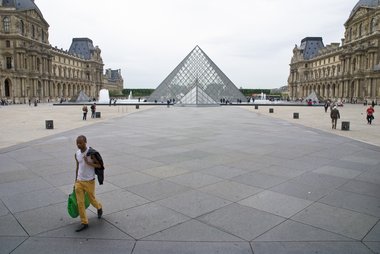
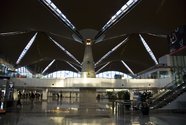



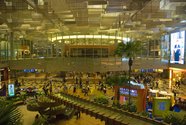
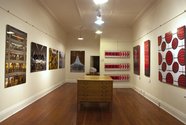
 Advertising in this column
Advertising in this column Two Rooms presents a program of residencies and projects
Two Rooms presents a program of residencies and projects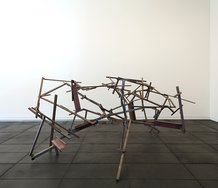
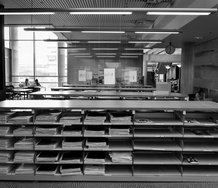
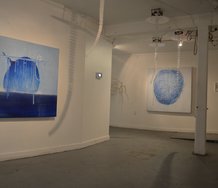
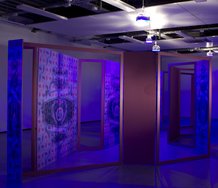
This Discussion has 0 comments.
Comment
Participate
Register to Participate.
Sign in
Sign in to an existing account.